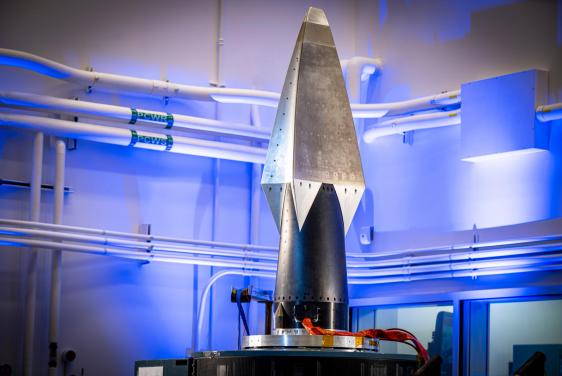Press Release
U.S. Air Force, Johns Hopkins APL Hypersonic Experiment Soars and Collects Vital Data
The Boundary Layer Transition 1B (BOLT-1B) experiment, a joint research project of the U.S. Air Force Research Laboratory (AFRL), the Johns Hopkins Applied Physics Laboratory (APL), and the German Aerospace Center (DLR), blasted off from Andøya Space in Norway aboard a sounding rocket on Sept. 2. The experiment traveled over the Norwegian Sea at Mach 7.2 and provided a stream of important data on the physics of airflow at hypersonic speeds.
“The data we gathered from the flight experiment will be critical for improving methods for designing future hypersonic vehicles, so we can reduce modeling uncertainties and optimize their performance,” said APL’s Brad Wheaton, chief scientist with the Vehicle Design and Technologies Group in APL’s Force Projection Sector and the project’s principal investigator.
BOLT-1B’s mission is to study a phenomenon called boundary layer transition (the flow of air around the skin of a hypersonic vehicle), which increases hypersonic vehicle drag and aerodynamic heating. The scientific data collected from the test will be used by researchers to validate new and more accurate modeling and prediction methods during the design of hypersonic vehicles.
To collect this data, the experiment, designed and built by APL, was loaded with instruments to take more than 400 measurements, with locations on the vehicle determined by an extensive research effort to better understand the physics of boundary layer transition on the BOLT vehicle’s geometry. As planned, the test concluded with BOLT-1B impacting the ocean approximately 185 kilometers (115 miles) offshore.
BOLT-1B is sponsored by AFRL’s Air Force Office of Scientific Research. Much of the experiment’s research effort on BOLT is led by APL’s Force Projection Sector, with key support from the Laboratory’s Air and Missile Defense and Space Exploration sectors and the Research and Exploratory Development Department. The project also includes key collaborations with international allies.

